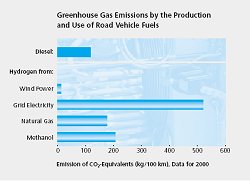EUHYFIS 2002
Major automakers such as DaimlerChrysler want to extend the mileage of
fuel cell buses by increasing vehicle tank pressure. Instead of 200 bar
today (2860 psi) the future standard will be 350 bar (5000 psi). This
requires compressors that can consolidate hydrogen gas in the filling
station storage up to 550 bar (7860 psi).
The development of a cost-efficient and performance-optimised piston compressor
which meets the above specification has started at Bauer Kompressoren
and is estimated to be completed in early 2003. The projected characteristics
of the new compressor are:

>> enlarge
In 2001 a detailed study of hydrogen fuel supply to
buses in public transport was completed at PLANET. The investigation followed
the rules for life cycle assessments as laid down in the series of standards
EN ISO 14040 – 14043. Seven scenarios were compared which rely on different
primary energy sources (e.g. coal, natural gas, wind and water power)
as well as various ways of energy conversion (electricity generation,
synthesis of methanol, liquefaction of hydrogen...).
Compared to previous works in this field, the data basis could be extended
substantially. It enabled the supply paths to be analysed stepby- step
and in detail from primary energy to the vehicle ("from well to wheel").
The crucial question was, which of the scenarios would come off well
in comparison to diesel, the standard fuel for buses today. The consumption
of fossil resources and, closely linked to this, the emission of greenhouse
gases belonged to the prime criteria. In this context, the "ecological
rucksack" had to be considered, i.e. the effort of energy and materials
to build the necessary infrastructure like chemical production facilities,
wind turbines, pipelines for transportation etc.
The figure below shows that hydrogen derived from wind power has a significant
ecological advantage over diesel. Other renewable energy sources yielded
similar results (not displayed here). Only the renewables therefore legitimate
the massive investment that will be required to convert the fuel supply
infrastructure to hydrogen use.

>> enlarge